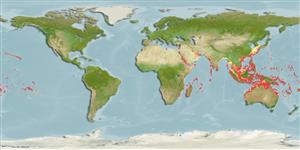Classification / Names
Common names from other countries
Main reference
Size / Weight / Age
Max length : 60.0 cm TL male/unsexed; (Ref. 2295); common length : 40.0 cm TL male/unsexed; (Ref. 2295); max. published weight: 5.9 kg (Ref. 40637)
Length at first maturity
Lm 27.5, range 18 - ? cm
Environment
Marine; reef-associated; non-migratory; depth range 1 - 100 m (Ref. 9710), usually 5 - 30 m (Ref. 9775)
Climate / Range
Tropical, preferred 28°C (Ref. 107945); 35°N - 30°S, 32°E - 130°W
Distribution
Short description
Dorsal
spines
(total): 10;
Dorsal
soft rays
(total): 10;
Anal
spines: 3;
Anal
soft rays: 9. The inner surface of the pectoral fin base is densely scaled. Body is generally bluish-gray grading to whitish on ventral parts; lips are yellow to pinkish. The area around the eye is often yellow or orange. Fins are generally without distinctive markings. The membranes are clear or dusky but often reddish to yellow-orange. The base of the upper pectoral fin rays and the inner base (i.e. the body side) of the pectoral axil are black. The caudal fin usually has blackish rays contrasted against the paler membranous part of the fin. Small juveniles (often also in large 20-30 cm individuals) whitish on lower half and with three prominent black saddles separated by narrower white bars on upper half. A vertical black bar crosses the eye from above.
IUCN Red List Status (Ref. 115185)
Threat to humans
Reports of ciguatera poisoning (Ref. 4690)
Human uses
Fisheries: commercial; gamefish: yes; aquarium: commercial
More information
ReferencesAquacultureAquaculture profileStrainsGeneticsAllele frequenciesHeritabilityDiseasesProcessingMass conversion
Tools
Special reports
Download XML
Internet sources
Estimates of some properties based on models
Phylogenetic diversity index
PD50 = 1.0000 many relatives (e.g. carps) 0.5 - 2.0 few relatives (e.g. lungfishes)
Trophic Level
3.4 ±0.0 se; Based on diet studies.
Resilience
Medium, minimum population doubling time 1.4 - 4.4 years (Preliminary K or Fecundity.)
Vulnerability
Moderate vulnerability (42 of 100)
Price category
